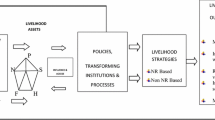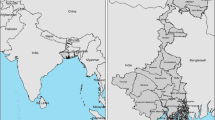Abstract
Based on the National Sample Survey Organisation (NSSO) Multiple Indicator Survey (MIS) data of 2020–2021, the present study has been carried out to investigate spatial heterogeneity in the pattern of multidimensional deprivation across social groups among major states in rural India. Employing the principal component analysis approach, the social group wise Multidimensional Deprivation Index (MDI) have been constructed considering eighteen relevant indicators related to housing, basic amenities, social and economic deprivations. According to the study, multidimensional deprivation is much higher among rural households in the Scheduled Tribe (ST) and Scheduled Caste (SC) categories than among other social groups. The study unveils that, SC households, mainly in the central and north-eastern parts of the nation, experience severe multidimensional deprivation. Of the states, Nagaland has the highest index score of 0.719 while Karnataka has the lowest index score − 0.962. Similarly, ST households in central and eastern Indian states experience acute deprivation, with Odisha experiencing the highest levels (0.663 MDI value) compared to − 0.723 in Sikkim. Meanwhile, Meghalaya (0.874) and Punjab (− 0.657) are the two most and least deprived states within the OBC social group. At the same time, though general categories households are comparatively well ahead than the other groups, a significant percentage of households within this category in two states, namely Mizoram and Jharkhand, suffer intense multidimensional deprivation requiring special attention. Considering all the social groups, the results explain that the central and the eastern regions are comparatively more deprived than the rest of the regions of the country due to poor performance of these states in most of the indicators of MDI. The analysis discloses that the states (like—Punjab, Haryana, Himachal Pradesh, Tamil Nadu, etc.) having a higher proportion of General and SC populations are comparatively less deprived. In contrary, except north-eastern states where the concentration of ST population is comparatively higher (like—Chhattisgarh, Jharkhand, Madhya Pradesh, Odisha) their deprivation is more. Hence, there is a need for an in-depth assessment of deprivation across the social groups to uncover their deprived conditions, and target-based new policies should be implemented for the deprived social groups in the deprived states of India.

Source: Prepared by Authors Based on Multiple Indicator Survey 2022
Similar content being viewed by others
References
Alkire, S., Oldiges, C., & Kanagaratnam, U. (2021). Examining multidimensional poverty reduction in India 2005/6–2015/16: Insights and oversights of the headcount ratio. World Development, 142, 105454. https://doi.org/10.1016/j.worlddev.2021.105454
Anand, I., & Thampi, A. (2016). Recent trends in wealth inequality in India. Economic and Political Weekly, 51(50), 59.
Ansary, R. & Das, B. (2018). Regional patterns of deprivation in India: An assessment based on household characteristics, basic amenities and asset possession. Social Change, 48(3), 367–383.
Baiju, K., & Sivaraman, S. (2018). Multidimensional poverty among social groups in Kerala: Incidence. Cambridge Scholars Publishing.
Bakshi, S., Chawla, A., & Shah, M. (2015). Regional disparities in India: A moving frontier. Economic and Political Weekly, 1, 44–52.
Basu, T., & Das, A. (2021). Formulation of deprivation index for identification of regional pattern of deprivation in rural India. Socio-Economic Planning Sciences, 74, 100924.
Basel, S., Gopakumar, K. U., & Rao, R. P. (2020). Testing club convergence of economies by using a broad-based development index. Geo Journal. https://doi.org/10.1007/s10708-020-10198-0
Bharti, N. K. (2018). Wealth inequality, class and caste in India, 1961–2012. WID. World Working Paper, 14.
Bhattacharjee, D., & Wang, J. (2011). Assessment of facility deprivation in the households of the North Eastern States of India. Demography India, 40(2), 35–54.
Bhuyan, B., Sahoo, B. K., & Suar, D. (2020). Food insecurity dynamics in India: A synthetic panel approach. Social Sciences and Humanities Open,. https://doi.org/10.1016/j.ssaho.2020.100029
Borooah, V. K. (2005). Caste, inequality, and poverty in India. Review of Development Economics, 9(3), 399–414.
Debroy, B. & Bhandari, L. (2003). District Level Deprivation In The New Millennium. Konark Publishers, New Delhi, India.
Deb, P., & Mukherjee, R. (2022). Pattern of regional disparities in the level of household deprivation among the scheduled tribes of Eastern India: A district-level analysis. Journal of Asian and African Studies. https://doi.org/10.1177/00219096221106097
Das, A., Das, M., & Barman, H. (2019). Access to basic amenities and services to urban households in West Bengal: Does its location and size of settlements matter? Geo Journal. https://doi.org/10.1007/s10708-019-10101-6
Goli, S., Maurya, N. K., & Sharma, M. K. (2015). Continuing caste inequalities in rural Uttar Pradesh. International Journal of Sociology and Social Policy, 35, 252–272. https://doi.org/10.1108/IJSSP-07-2014-0051
Governement of India, GOI (2011). Census of India. Office of the Registrar General & Census Commissioner.
Haan, A. (2004). Disparities within India’s poorest regions: Why do the same institutions work differently in different places? Equity and Development, World Development Report 2006.
Hall, G. H., & Harry, A. P. (Eds.). (2012). Indigenous peoples, poverty, and development. Cambridge University Press.
Jayadev, A., Motiram, S., & Vakulabharanam, V. (2007). Patterns of wealth disparities in India during the liberalisation era. Economic and Political Weekly, 42(38), 3853–3863.
Jayaraj, D. & Subramanian, S. (2010). A Chakravarty-D’Ambrosio View of Multidimensional Deprivation: Some Estimates for India. Economic and Political Weekly, 45(6), 53–65. http://www.jstor.org/stable/25664091
Joseph, M. (2004). Northern states versus southern states: A comparative analysis. Working paper No. 134. Indian Council for Research on International Economic Relations (pp. 1–78).
Kaiser, H. F. (1960). The application of electronic computers to factor analysis. Educational and Psychological Measurement, 20, 141–151. https://doi.org/10.1177/001316446002000116
Khan, M. A., & Rehman, H. U. (2012). Regional disparities in human capital: The case of Pakistan. Pakistan Economic and Social Review, 50(1), 57–69.
Kumari, R., & Raman, R. (2022). Regional disparities in healthcare services in Uttar Pradesh, India: A principal component analysis. GeoJournal, 87(6), 5027–5050.
Kumari, R., Raman, R., & Patel, R. K. (2023). Regional disparities in social, environmental, and economic indicators among the Indian States. GeoJournal, 88, 4351–4371. https://doi.org/10.1007/s10708-023-10868-9
Madheswaran, S., & Attewell, P. (2007). Caste discrimination in the Indian urban labour market: Evidence from the national sample survey. Economic and Political Weekly, 42(41), 4146–4153.
Mahmoud, S. C., Wadood, N. S., & Ahmed, S. K. (2008). Addressing regional inequality issues in Bangladesh public expenditure. Munich Personal RePEc Archive, 1–33. https://mpra.ub.uni-muenchen.de/14568/
Marjit, S., Sasmal, R., & Sasmal, J. (2020). Composition of public expenditure and growth of per capita income in Indian states: A political perspective. Journal of Social and Economic Development, 22, 1–17.
Mishra, B. (2019). Inter-state Disparities in the Reduction of Multidimensional Deprivations in India. Indian Journal of Human Development, 13(3), 239–253.
Mondal, S., Kumar, V., & Sahoo, P. (2023). Multidimensional deprivation in Rural India: A state-level analysis. Economic and Political Weekly, 58(33), 37–45.
Nolan, L. B., Bloom, D. E., & Subbaraman, R. (2017). Legal Status and Deprivation in Urban Slums over Two Decades. Economic and Political Weekly, 53(15), 47–55.
Osaragi T. (2002). Classification methods for spatial data representation. Centre for Advanced Spatial Analysis University College London; Paper 40. http://www.casa.ucl.ac.uk/paper40.pdf
Pradhan, I., Kandapan, B., & Pradhan, J. (2022). Uneven burden of multidimensional poverty in India: A caste based analysis. PLoS ONE, 17(7), e0271806. https://doi.org/10.1371/journal.pone.0271806
Quackenbush, J. (2002). Microarray data normalization and transformation. Nature Genetics, 32(4), 496–501.
Sahoo, B. K., & Neog, B. J. (2017). Heterogeneity and participation in informal employment among non-cultivator workers in India. International Review of Applied Economics, 31(4), 437–467. https://doi.org/10.1080/02692171.2016.1257584
Sarkar, A., & Chouhan, P. (2023). Spatial analysis of multi-level deprivation in urban settings of West Bengal. GeoJournal, 88, 247–260. https://doi.org/10.1007/s10708-022-10576-w
Sarkar, B., Banerji, H., & Sen, J. (2014). Patterns of socioeconomic deprivation and its impact on quality of life: Case of a less developed region in West Bengal India. Athens Journal of Health, 1(4), 271–286.
Sharma, V. (2015). Are BIMARU states still Bimaru? Economic and Political Weekly, 50(18), 58–63.
Singh, A., Kumar, K., & Singh, A. (2015). Exclusion within the excluded: The economic divide within scheduled castes and scheduled tribes. Economic and Political Weekly, 42(32–37), 32–37.
Tiwari, C., Goli, S., Siddiqui, M. Z., & Salve, P. S. (2022). Poverty, wealth inequality and financial inclusion among castes in Hindu and Muslim communities in Uttar Pradesh, India. Journal of International Development, 34(6), 1227–1255. https://doi.org/10.1002/jid.3626
UNDP (2021). Global Multidimensional Poverty Index 2021 Unmasking disparities by ethnicity, caste and gender. Retrieved from: https://ophi.org.uk/multidimensional-poverty-index/
World Bank (2023). Multidimensional Poverty Measure. Retrieved from https://www.worldbank.org/en/topic/poverty/brief/multidimensional-poverty-measure
Funding
Funding was received from IOE BHU to assist with the preparation of this manuscript.
Author information
Authors and Affiliations
Corresponding author
Ethics declarations
Conflict of interest
The authors have no relevant financial or non-financial interests with any individual, institute, or agency to disclose.
Consent for publication
All authors consent to participate and publication of the article.
Ethical approval
This article does not contain any studies with human participants or animals performed by any of the authors.
Additional information
Publisher's Note
Springer Nature remains neutral with regard to jurisdictional claims in published maps and institutional affiliations.
Appendix
Appendix
See Tables 5, 6 , 7 , 8 , 9 , 10 , 11 , 12 and 13.
Rights and permissions
Springer Nature or its licensor (e.g. a society or other partner) holds exclusive rights to this article under a publishing agreement with the author(s) or other rightsholder(s); author self-archiving of the accepted manuscript version of this article is solely governed by the terms of such publishing agreement and applicable law.
About this article
Cite this article
Sahoo, P., Mondal, S. & Kumar, V. Multidimensional deprivations among social groups in rural India: A state level analysis. GeoJournal 88, 6137–6159 (2023). https://doi.org/10.1007/s10708-023-10961-z
Accepted:
Published:
Issue Date:
DOI: https://doi.org/10.1007/s10708-023-10961-z




